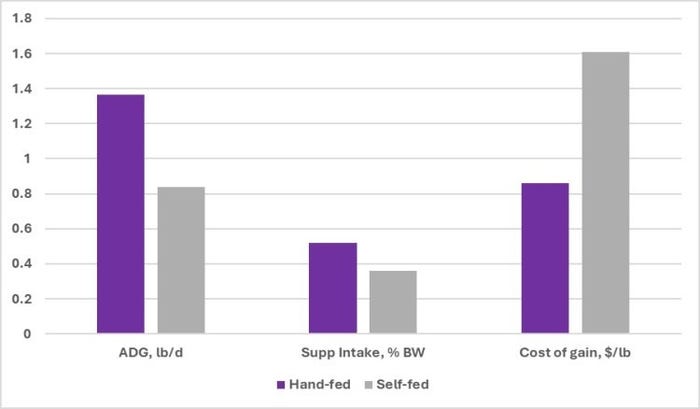Self-fed lick tubs for supplementing protein to grazing cattle
Posted on May 21, 2024
Source: Farm Progress. The original article is posted here.

Protein supplementation is a critical component of maximizing forage utilization in grazing cattle operations, particularly cow-calf operations. Rumen-degradable protein is needed by microorganisms in the rumen to digest the plant cell wall fibers. Research has demonstrated that providing a protein supplement daily will increase forage digestibility and forage intake in beef cows consuming low-quality (< 65 crude protein) forage. However, this can increase labor costs and is difficult for part-time ranchers. This has led to the development of products such as self-fed lick tubs to provide a constant supply of rumen degradable protein with little additional labor.
Lick tubs are designed to allow daily access to a high protein supplement while managing supplement intake. Consumption of a lick tub can be managed by the inclusion of an intake limiter or by the hardness of the tub. A question that is commonly asked is “Are lick tubs as effective as daily hand feeding of a supplement?”.

A recent study compared feeding dried distillers’ grains in meal form daily with a self-fed dried distillers’ grains tub to calves grazing corn stalk residue. Calves with access to the self-fed tub gained less likelihood because they consumed less supplement than calves fed the meal form of dried distillers’ grains. The self-fed tub also had a greater cost of gain than the meal form. Another study reported that beef cows provided a molasses-based self-fed tub had similar supplement intake and weight gain as those hand-fed a supplement daily.
Consumption of tubs appears to be highly variable among published studies with some studies showing that all animals in the group refused to consume the tub. Additionally, variation in consumption of the tubs among individuals within a group is high. The percentage of animals that refuse to consume supplements is generally lower with supplements that are hand-fed daily and the variation in individual intake is less than with self-fed tubs.
There are several factors affecting the consumption of tubs. One factor is the hardness of the tub; increasing tub hardness tends to increase the percentage of cattle refusing to consume the tub and increases the variation in individual intake. However, the trade-off with softer tubs is that overconsumption may incur increasing costs. Cattle with no previous experience with a self-fed tub will likely have low intakes for some time as the cattle learn to accept that the tub is safe to consume, and the percentage of non-feeders and variation in individual intake will decrease with exposure time. Additionally, limited availability will enhance social dominance factors among cattle in the herd increasing the variation in individual intake.
The use of self-fed tubs can be more convenient than daily hand-fed supplements but may increase the cost of gain primarily if intake of the self-fed tubs are less than expected. If hand-fed supplements are not a viable option, ensuring adequate intake of self-fed tubs is necessary. To ensure adequate intake, be sure that cattle are not overstocked relative to tub availability (number of animals per tub) and that tub hardness is optimal for the targeted consumption. Tub intake should be monitored by recording tub weight, the date that new tubs are placed in the pasture, the number of heads in the pasture, and the date that the tubs are empty. Average daily consumption can be calculated using the following formula:
Average daily consumption = (𝑡𝑢𝑏 𝑤𝑒𝑖𝑔ℎ𝑡/𝑛𝑢𝑚𝑏𝑒𝑟 𝑜𝑓 𝑐𝑎𝑡𝑡𝑙𝑒)/ (Empty date – Start date)

.jpg?disable=upscale&width=1200&height=630&fit=crop)


